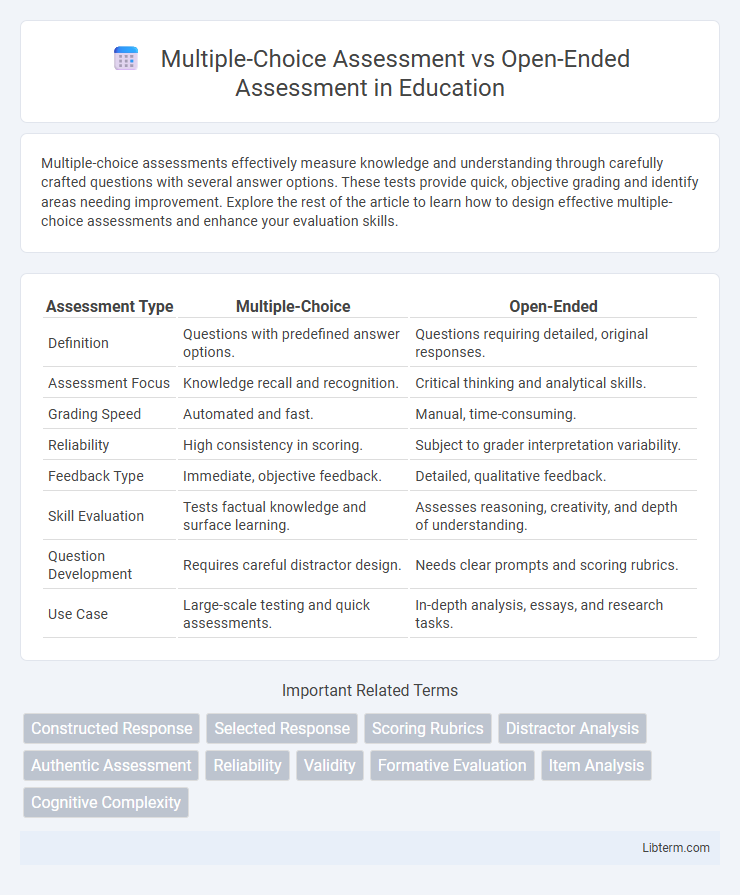Multiple-choice assessments effectively measure knowledge and understanding through carefully crafted questions with several answer options. These tests provide quick, objective grading and identify areas needing improvement. Explore the rest of the article to learn how to design effective multiple-choice assessments and enhance your evaluation skills.
Table of Comparison
| Assessment Type | Multiple-Choice | Open-Ended |
|---|---|---|
| Definition | Questions with predefined answer options. | Questions requiring detailed, original responses. |
| Assessment Focus | Knowledge recall and recognition. | Critical thinking and analytical skills. |
| Grading Speed | Automated and fast. | Manual, time-consuming. |
| Reliability | High consistency in scoring. | Subject to grader interpretation variability. |
| Feedback Type | Immediate, objective feedback. | Detailed, qualitative feedback. |
| Skill Evaluation | Tests factual knowledge and surface learning. | Assesses reasoning, creativity, and depth of understanding. |
| Question Development | Requires careful distractor design. | Needs clear prompts and scoring rubrics. |
| Use Case | Large-scale testing and quick assessments. | In-depth analysis, essays, and research tasks. |
Introduction to Assessment Types
Multiple-choice assessments provide structured response options, allowing for efficient scoring and objective measurement of knowledge across diverse subjects. Open-ended assessments require test-takers to generate answers, encouraging critical thinking, creativity, and detailed explanations. Both assessment types offer unique advantages for evaluating different cognitive skills and learning outcomes in educational settings.
Defining Multiple-Choice Assessment
Multiple-choice assessment involves presenting learners with a question followed by several answer options, where only one is correct. This format allows for efficient grading and objective measurement of knowledge across broad topics. It is widely used in standardized testing due to its reliability and ability to assess recall and recognition skills.
Understanding Open-Ended Assessment
Open-ended assessments evaluate critical thinking and problem-solving skills by requiring students to construct detailed responses, enabling educators to gauge depth of understanding beyond factual recall. This format promotes creativity, analytical reasoning, and the ability to articulate complex ideas, making it essential for disciplines that emphasize nuanced comprehension. Unlike multiple-choice assessments, open-ended assessments provide insight into students' thought processes and personalized learning needs.
Key Differences Between the Two Formats
Multiple-choice assessments provide objective grading through pre-defined answer options, enabling efficient evaluation of factual knowledge and quick scoring consistency. Open-ended assessments require subjective grading based on detailed explanations or creative responses, allowing deeper insight into critical thinking, reasoning, and synthesis abilities. While multiple-choice tests prioritize breadth and speed, open-ended formats emphasize depth and originality in student understanding.
Advantages of Multiple-Choice Assessments
Multiple-choice assessments offer objective grading, ensuring consistency and minimizing bias compared to open-ended assessments. They efficiently evaluate a wide range of content knowledge, enabling quick feedback and large-scale testing. Their structured format supports statistical analysis of performance, aiding in identifying knowledge gaps and improving instructional strategies.
Benefits of Open-Ended Assessments
Open-ended assessments promote critical thinking and creativity by allowing students to express their understanding in their own words and elaborate on complex ideas. They provide deeper insight into student knowledge and reasoning processes, enabling educators to identify misconceptions and tailor instruction more effectively. These assessments also encourage higher-order cognitive skills such as analysis, synthesis, and evaluation, which are essential for comprehensive learning.
Limitations of Multiple-Choice Questions
Multiple-choice questions often limit the depth of student understanding by focusing on recognition rather than critical thinking or problem-solving skills. They can encourage guessing, which may not accurately reflect a learner's knowledge or competency level. The format restricts the ability to assess complex reasoning, creativity, and the ability to generate original responses compared to open-ended assessments.
Challenges in Open-Ended Assessments
Open-ended assessments present challenges such as increased subjectivity in grading, requiring extensive time and expertise to evaluate nuanced responses accurately. These assessments demand sophisticated rubrics to ensure consistency and reliability across different evaluators. Furthermore, analyzing large volumes of open-ended data can be resource-intensive, limiting scalability in educational settings.
Choosing the Right Assessment Method
Choosing the right assessment method involves evaluating the goals of the evaluation, the depth of understanding required, and the context of the learning environment. Multiple-choice assessments efficiently measure recall and recognition across large groups, offering rapid grading and quantitative data analysis. Open-ended assessments foster critical thinking and creativity by allowing learners to articulate their reasoning, making them ideal for evaluating complex problem-solving skills and deeper comprehension.
Conclusion: Balancing Assessment Approaches
Balancing multiple-choice assessments and open-ended assessments allows educators to measure both factual knowledge and critical thinking skills effectively. Combining objective scoring with opportunities for expressive responses ensures a comprehensive evaluation of student learning. Optimizing assessment strategies enhances overall educational outcomes by addressing diverse cognitive abilities.
Multiple-Choice Assessment Infographic

 libterm.com
libterm.com